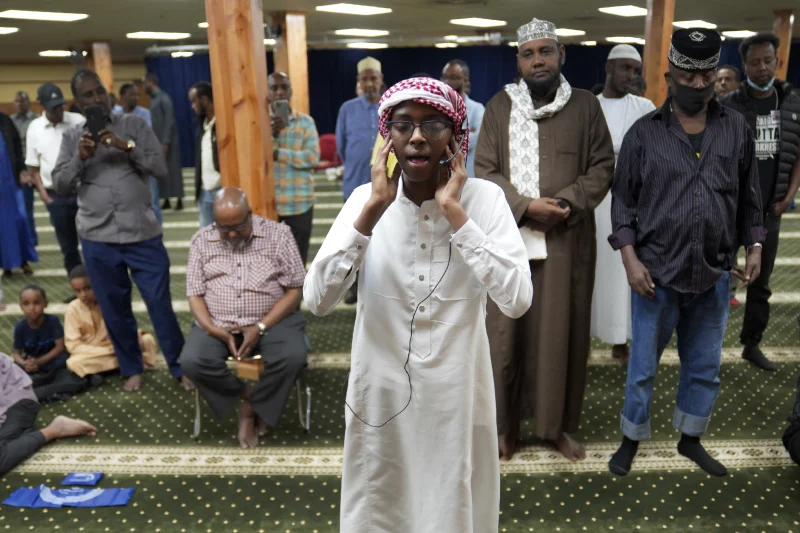
The chant in Arabic blasts from rooftop loudspeakers, drowning out both the growl of traffic from nearby interstates and the chatter and clinking glasses on the patio of the dive bar that shares a wall with Minneapolis’s oldest Somali mosque.
This spring, Minneapolis, Minnesota, became the first large city in the US to allow the Islamic call to prayer, or adhan, to be broadcast publicly by its two dozen mosques.
As more of them get ready to join the Dar Al-Hijrah mosque in doing so, the transforming soundscape is testament to the large and increasingly visible Muslim community, which is greeting the change with both celebration and caution, lest it cause backlash.
“It’s a sign that we are here,” said Yusuf Abdulle, who directs the Islamic Association of North America, a network of three dozen mostly East African mosques. Half of them are in Minnesota, home to rapidly growing numbers of refugees from war-torn Somalia since the late 1990s.
Mr Abdulle said that when he arrived in the US two decades ago, “the first thing I missed was the adhan. We drop everything and answer the call of God”.
The cadences of the adhan are woven into the rhythm of daily life in Muslim-majority countries, but it’s a newcomer to the streets of Minneapolis, which resonate with city traffic, the rumble of snowplows in winter and tornado siren drills in summer.
Al-Hijrah got a special permit to broadcast the call to prayer for Ramadan in the spring of 2020, when Minnesota was under a pandemic lockdown, so the faithful could hear it from home, mosque director Wali Dirie said.
Soon it was resounding from speakers set up with the help of First Avenue, a nightclub made famous by Prince.
:quality(70)/cloudfront-eu-central-1.images.arcpublishing.com/thenational/QTQ7S3P2BTPYZYG2UC3W5XWFCM.jpg)
That community need led to the recent resolution authorising the broadcasts more broadly. It establishes decibel levels and hourly limits in line with the city’s noise ordinance, meaning that the early-morning and late-night calls to prayer are only aired indoors.
At Dar Al-Hijrah now, elders call the prayer three times a day, drawing youths like Mohamad Mooh, 17, who arrived only five months ago. He said he wishes the broadcasts were even louder like back in Somalia, where the early morning calls woke him up.
“I know it’s a little bit complicated because of the society,” Mohamad added after a recent packed prayer service.
As some Americans opposed church bells in the 19th century, the call to prayer has led to disputes over the years, from Duke University to Culver City, California.
In Hamtramck, a small city surrounded by Detroit, councillors exempted religious sounds from the noise ordinance at a mosque’s request. Coming in the aftermath of 9/11, the amendment got embroiled in national controversy, but a referendum to revoke it failed.
In the predominantly Somali neighbourhood of Cedar-Riverside, tucked between the city centre and two college campuses, Dar Al-Hijrah mosque’s adhan has met no backlash.
:quality(70)/cloudfront-eu-central-1.images.arcpublishing.com/thenational/76DUSVYXIZRBPMATRJLC534WEA.jpg)
Hoping to also prevent it, the Abubakar As-Saddique Islamic Centre in south Minneapolis, which hosts about 1,000 men for Friday midday prayers, plans to hold meetings with neighbours before broadcasting publicly this summer.
“We care about the neighbours,” said Abdullahi Farah, the centre’s director. “We have to talk to them, explain to them and at least share our views on this.”
Between hesitancy to provoke tension, technical complexities and the challenges of arranging for someone with the skills to chant the call live, several mosques may decide not to broadcast, said Jaylani Hussein, director of the Minnesota chapter of the Council on American-Islamic Relations.
But other mosques are already eager to push for permission to broadcast all five prayers and hope to see Minneapolis set an example for cities across the country.
“We want Muslims to fully exist here in America,” Mr Hussein said and added that the adhan is the “last piece to make this home”.
“It’s incredibly important for Muslims to know their religious rights are never infringed upon.”
Several neighbourhood groups consulted by The Associated Press said that while no formal discussions have been held yet, they expect most residents will be accepting.
Mowlid Ali, the imam at Abubakar, said part of the aim in broadcasting the adhan is precisely that mix of claiming belonging and outreach.
“We hope that through calling the adhan in public, it would actually bring more interest from the neighbours in knowing about the religion of Islam,” Mr Ali said.
Source: AP

Leave a Reply